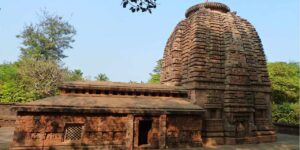
The Parasurameswara Temple, located in Bhubaneswar, Odisha, India, stands as a testament to the rich cultural and architectural heritage of the region. This ancient Hindu temple, dedicated to Lord Shiva in the form of Parasurameswara, is a prominent example of the Kalinga style of architecture, dating back to the 7th century. In this detailed exploration, we’ll delve into various aspects of the Parasurameswara Temple, including its history, architecture, religious significance, rituals, and its place in the cultural tapestry of India.
History:
The Parasurameswara Temple is believed to have been constructed around the 7th century, making it one of the oldest surviving temples in Bhubaneswar. This period corresponds to the flourishing of the Kalinga dynasty, and the temple bears witness to the architectural prowess of that era. While the exact date of its construction is challenging to determine, historical records and archaeological findings suggest that the temple has endured centuries, reflecting the continuity of religious practices in the region.
During this time, Bhubaneswar was a prominent center for temple construction, and the Parasurameswara Temple became an integral part of the religious landscape. The region has a rich tradition of temple building, evident in the numerous ancient structures that dot the landscape, each contributing to the historical and cultural narrative of the area.
Architecture:
The architectural style of the Parasurameswara Temple is characteristic of the Kalinga style, a distinctive form of architecture prevalent in the region. This style is known for its emphasis on intricate carvings, detailed sculptures, and the use of local materials. The temple follows the typical plan of a sanctum, a porch, and a dancing hall, showcasing the tri-ratha (threefold division) style commonly found in Odisha temples.
One of the notable features of the temple is its decorated exterior walls. Elaborate carvings adorn the surfaces, depicting various scenes from Hindu mythology, celestial beings, and intricate patterns. The carvings include depictions of Lord Shiva in various forms, scenes from the epics like the Mahabharata and Ramayana, and a plethora of mythical creatures.
The main sanctum of the temple houses the Shiva lingam, representing Lord Parasurameswara. The sanctum is intricately designed with sculpted doorframes and panels. The exterior walls also feature sculptures of deities such as Ganesha, Parvati, Kartikeya, and others, reflecting the inclusive nature of Hinduism.
Cultural and Religious Significance:
The Parasurameswara Temple holds immense cultural and religious significance in the region. As a sacred site dedicated to Lord Shiva, it attracts devotees and pilgrims from far and wide. The temple is a repository of cultural and artistic expressions, capturing the essence of the times in which it was built.
The Kalinga style, exemplified by the Parasurameswara Temple, is an important facet of Odisha’s cultural identity. The intricate artwork and architectural details reflect the skilled craftsmanship of the artisans who crafted this marvel centuries ago. The temple serves as a link between the past and the present, connecting contemporary worshippers with the rich heritage of their ancestors.
The religious significance of the Parasurameswara Temple is heightened during festivals dedicated to Lord Shiva. Devotees gather to offer prayers, perform rituals, and partake in the festivities that mark these occasions. The temple becomes a hub of religious and cultural activities, fostering a sense of community among its worshippers.
Rituals and Festivals:
The Parasurameswara Temple is a vibrant center of religious practices, with regular rituals and festivals enriching its spiritual ambiance. Daily pujas, or religious ceremonies, are conducted by the temple priests to honor Lord Parasurameswara. These rituals follow traditional procedures prescribed in Hindu scriptures, creating a sacred atmosphere within the temple precincts.
Several festivals are celebrated with grandeur at the Parasurameswara Temple, drawing devotees and tourists alike. Maha Shivaratri, dedicated to Lord Shiva, is one of the most significant festivals observed here. Devotees fast, offer prayers, and engage in devotional activities during this auspicious occasion. The temple’s sanctum witnesses a surge in pilgrims seeking the divine blessings of Lord Parasurameswara.
Conservation and Preservation:
Given its historical significance, the Parasurameswara Temple has been subject to various preservation efforts to ensure its longevity. Conservation projects aim to protect the temple from environmental factors, structural decay, and the impact of tourism. These initiatives often involve collaboration between archaeological departments, local communities, and heritage organizations.
Efforts are made to document the temple’s architecture, sculptures, and inscriptions to contribute to the understanding of ancient Indian art and history. Conservationists work to strike a balance between preserving the authenticity of the site and making it accessible for visitors who wish to explore its cultural and historical richness.
Conclusion:
The Parasurameswara Temple stands as a living testament to the enduring cultural and religious legacy of Bhubaneswar. Its ancient stones echo with the prayers of countless devotees who have sought solace and spiritual connection within its hallowed walls. As a marvel of Kalinga architecture, the temple invites admiration for its intricate carvings and timeless beauty.
In a world that constantly evolves, the Parasurameswara Temple remains steadfast, rooted in the ancient traditions of Odisha. It not only serves as a place of worship but also as a beacon of cultural pride, connecting generations and preserving the essence of a bygone era. As visitors stand in awe of its architectural grandeur, they are transported through time, gaining a deeper appreciation for the rich tapestry of India’s cultural and religious heritage embodied by the Parasurameswara Temple.
—
Thanks,
with regards,
Mr. Raj Sharma (Director)
Garhwal Himalayan Expedition
{ App. by ministry of tourism }
Contact no. 9811275279
Whatsapp no. 9717237624
Office no. 011-47094166, 011-45458806
Travel Agency Address:-
B 2 / 263 1ST FLOOR, ROHINI SECTOR – 6 DELHI – 110085
Email Id:- rsrajindia1@gmail.com / garhwal.exp@gmail.com
